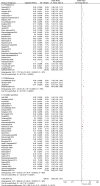Prevalence of and reasons for women's, family members', and health professionals' preferences for cesarean section in Iran: a mixed-methods systematic review
- PMID: 33388072
- PMCID: PMC7778821
- DOI: 10.1186/s12978-020-01047-x
Prevalence of and reasons for women's, family members', and health professionals' preferences for cesarean section in Iran: a mixed-methods systematic review
Abstract
Background: Cesarean section (CS) rates have been increasing globally. Iran has one of the highest CS rates in the world (47.9%). This review was conducted to assess the prevalence of and reasons for women's, family members', and health professionals' preferences for CS in Iran.
Methods and findings: In this mixed-methods systematic review, we searched MEDLINE/PubMed, Embase, CINAHL, POPLINE, PsycINFO, Global Health Library, Google scholar; as well as Iranian scientific databases including SID, and Magiran from 1 January 1990 to 8th October 2019. Primary quantitative, qualitative, and mixed-methods studies that had been conducted in Iran with Persian or English languages were included. Meta-analysis of quantitative studies was conducted by extracting data from 65 cross-sectional, longitudinal, and baseline measurements of interventional studies. For meta-synthesis, we used 26 qualitative studies with designs such as ethnography, phenomenology, case studies, and grounded theory. The Review Manager Version 5.3 and the Comprehensive Meta-Analysis (CMA) software were used for meta-analysis and meta-regression analysis. Results showed that 5.46% of nulliparous women (95% CI 5.38-5.50%; χ2 = 1117.39; df = 28 [p < 0.00001]; I2 = 97%) preferred a CS mode of delivery. Results of subgroup analysis based on the time of pregnancy showed that proportions of preference for CS reported by women were 5.94% (95% CI 5.86-5.99%) in early and middle pregnancy, and 3.81% (95% CI 3.74-3.83%), in late pregnancy. The heterogeneity was high in this review. Most women were pregnant, regardless of their parity; the risk level of participants were unknown, and some Persian publications were appraised as low in quality. A combined inductive and deductive approach was used to synthesis the qualitative data, and CERQual was used to assess confidence in the findings. Meta-synthesis generated 10 emerging themes and three final themes: 'Women's factors', 'Health professional factors', andex 'Health organization, facility, or system factors'.
Conclusion: Despite low preference for CS among women, CS rates are still so high. This implies the role of factors beyond the individual will. We identified a multiple individual, health facility, and health system factors which affected the preference for CS in Iran. Numerous attempts were made in recent years to design, test and implement interventions to decrease unnecessary CS in Iran, such as mother-friendly hospitals, standard protocols for labor and birth, preparation classes for women, midwives, and gynaecologists, and workshops for specialists and midwives through the "health sector evolution policy". Although these programs were effective, high rates of CS persist and more efforts are needed to optimize the use of CS.
Keywords: Cesarean section; Iran; Mixed method; Qualitative synthesis; Quantitative analysis; Vaginal birth.
Conflict of interest statement
The authors declare that they have no competing interests.
Figures




Similar articles
-
Non-clinical interventions for reducing unnecessary caesarean section.Cochrane Database Syst Rev. 2018 Sep 28;9(9):CD005528. doi: 10.1002/14651858.CD005528.pub3. Cochrane Database Syst Rev. 2018. PMID: 30264405 Free PMC article.
-
Discontinuation of intravenous oxytocin in the active phase of induced labour.Cochrane Database Syst Rev. 2018 Aug 20;8(8):CD012274. doi: 10.1002/14651858.CD012274.pub2. Cochrane Database Syst Rev. 2018. PMID: 30125998 Free PMC article.
-
Signs and symptoms to determine if a patient presenting in primary care or hospital outpatient settings has COVID-19.Cochrane Database Syst Rev. 2022 May 20;5(5):CD013665. doi: 10.1002/14651858.CD013665.pub3. Cochrane Database Syst Rev. 2022. PMID: 35593186 Free PMC article.
-
Women's and communities' views of targeted educational interventions to reduce unnecessary caesarean section: a qualitative evidence synthesis.Reprod Health. 2018 Jul 24;15(1):130. doi: 10.1186/s12978-018-0570-z. Reprod Health. 2018. PMID: 30041661 Free PMC article.
-
Cost-effectiveness of using prognostic information to select women with breast cancer for adjuvant systemic therapy.Health Technol Assess. 2006 Sep;10(34):iii-iv, ix-xi, 1-204. doi: 10.3310/hta10340. Health Technol Assess. 2006. PMID: 16959170
Cited by
-
In-Depth Analysis of Caesarean Section Rate in the Largest Secondary Care-Level Maternity Hospital in Latvia.J Clin Med. 2023 Oct 9;12(19):6426. doi: 10.3390/jcm12196426. J Clin Med. 2023. PMID: 37835069 Free PMC article.
-
Rising caesarean section rates and factors affecting women's decision-making about mode of birth in Indonesia: a longitudinal qualitative study.BMJ Glob Health. 2024 Jun 18;9(6):e014602. doi: 10.1136/bmjgh-2023-014602. BMJ Glob Health. 2024. PMID: 38897616 Free PMC article.
-
Evaluating patients' choice of general and spinal anesthesia for elective cesarean section and associated factors: a descriptive study.Ann Med Surg (Lond). 2023 Jan 12;85(1):6-12. doi: 10.1097/MS9.0000000000000010. eCollection 2023 Jan. Ann Med Surg (Lond). 2023. PMID: 36742112 Free PMC article.
-
Effect of birth plans integrated into childbirth preparation classes on maternal and neonatal outcomes of Iranian women: A randomized controlled trial.Front Glob Womens Health. 2023 Apr 6;4:1120335. doi: 10.3389/fgwh.2023.1120335. eCollection 2023. Front Glob Womens Health. 2023. PMID: 37091299 Free PMC article.
-
Relationship between Primigravid women's awareness, attitude, fear of childbirth, and mode of delivery preference.Eur J Obstet Gynecol Reprod Biol X. 2022 Jan 25;14:100143. doi: 10.1016/j.eurox.2022.100143. eCollection 2022 Apr. Eur J Obstet Gynecol Reprod Biol X. 2022. PMID: 35141516 Free PMC article.
References
-
- Ye J, Zhang J, Mikolajczyk R, Torloni M, Gülmezoglu A, Betran A. Association between rates of caesarean section and maternal and neonatal mortality in the 21st century: a worldwide population-based ecological study with longitudinal data. BJOG Int J Obstetr Gynaecol. 2016;123(5):745–753. doi: 10.1111/1471-0528.13592. - DOI - PMC - PubMed
Publication types
MeSH terms
Grants and funding
LinkOut - more resources
Full Text Sources
Other Literature Sources
Medical
Miscellaneous

